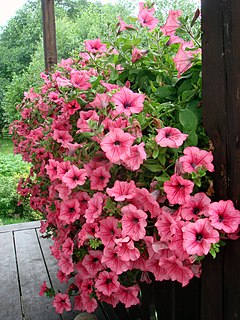
Ornamental plants are plants that are grown for decorative purposes in gardens and landscape design projects, as houseplants, cut flowers and specimen display. The cultivation of ornamental plants comes under floriculture and tree nurseries, which is a major branch of horticulture.
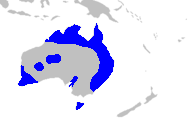
Xanthorrhoea is a genus of about 30 species of flowering plants endemic to Australia. Species are known by the name grass tree.

A perennial plant or simply perennial is a plant that lives more than two years. The term is often used to differentiate a plant from shorter-lived annuals and biennials. The term is also widely used to distinguish plants with little or no woody growth from trees and shrubs, which are also technically perennials.
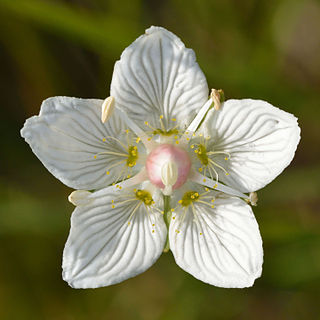
Parnassia palustris, commonly called marsh grass of Parnassus, northern grass-of-Parnassus, or just grass-of-Parnassus, and bog star, is a flowering plant in the staff-vine family Celastraceae.

Kingia is a genus consisting of a single species, Kingia australis, and belongs to the plant family Dasypogonaceae. It has a thick pseudo-trunk consisting of accumulated leaf-bases, with a cluster of long, slender leaves on top. The trunk is usually unbranched, but can branch if the growing tip is damaged. Flowers occur in egg-shaped clusters on the ends of up to 100 long curved stems. Kingia grows extremely slowly, the trunk increasing in height by about 1½ centimetres per year. It can live for centuries, however, so can attain a substantial height; 400-year-old plants with a height of six metres are not unusual.
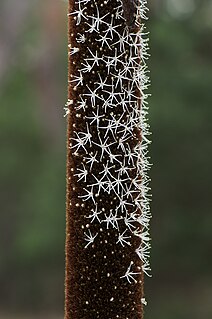
Xanthorrhoea australis, the grass tree, austral grasstree or blackboy, is an Australian plant. It is the most commonly seen species of the genus Xanthorrhoea. Its trunk can grow up to several metres tall and is often branched. In certain Aboriginal languages, it is called bukkup, baggup or kawee.
This page provides a glossary of plant morphology. Botanists and other biologists who study plant morphology use a number of different terms to classify and identify plant organs and parts that can be observed using no more than a handheld magnifying lens. This page provides help in understanding the numerous other pages describing plants by their various taxa. The accompanying page—Plant morphology—provides an overview of the science of the external form of plants. There is also an alphabetical list: Glossary of botanical terms. In contrast, this page deals with botanical terms in a systematic manner, with some illustrations, and organized by plant anatomy and function in plant physiology.

Melaleuca viminalis, commonly known as weeping bottlebrush, or creek bottlebrush is a plant in the myrtle family, Myrtaceae and is endemic to New South Wales, Queensland and Western Australia. It is a multi-trunked, large shrub or tree with hard bark, often pendulous foliage and large numbers of bright red bottlebrush flowers in spring and summer. It is possibly the most commonly cultivated melaleuca in gardens and its cultivars are often grown in many countries.

Beaufortia sparsa, commonly known as the swamp bottlebrush, is a plant in the myrtle family, Myrtaceae and is endemic to the south-west of Western Australia. It is an erect or spreading shrub with round, dished leaves crowded on the younger stems, and bright red flower spikes in the warmer months.
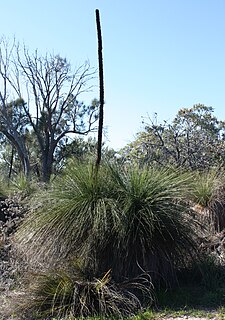
Xanthorrhoea preissii, known as balga, is a widespread species of perennial monocot in Southwest Australia.

Xanthorrhoea glauca, known as the grass tree, is a large plant in the genus Xanthorrhoea, widespread in eastern Australia. The trunk can grow in excess of 5 metres tall, and may be many branched. It is occasionally seen in large communities in nutrient rich soils. The leaves are a grey or bluish glaucous green.

Xanthorrhoea resinosa, is known as one of the grass trees, a mid-sized plant in the genus Xanthorrhoea. The specific epithet is from the Latin, meaning “having resin”. This perennial shrub is found in heathland or eucalyptus forest.
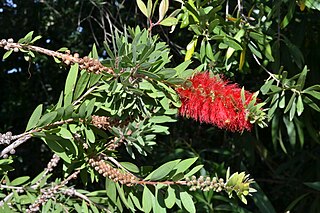
Melaleuca citrina, commonly known as common red bottlebrush, crimson bottlebrush, or lemon bottlebrush, is a plant in the myrtle family Myrtaceae, and is endemic to New South Wales and Victoria in Australia. Some Australian state herbaria continue to use the name Callistemon citrinus. Callistemon lanceolatus is an older name. It is a hardy and adaptable species, common in its natural habitat. It is widely cultivated, not only in Australia, often as a species of Callistemon. It was one of the first Australian plants to be grown outside the country, having been taken to England in 1770 by Joseph Banks. Its showy red flower spikes, present over most of the year in an ideal situation, account for its popularity.
Melaleuca quercina, commonly known as Oakey bottlebrush is a plant in the myrtle family, Myrtaceae and is endemic to a small area of Queensland in Australia. It is small tree with dark, corky bark and spikes of yellow, cream or pink bottlebrush flowers in spring and summer.

Melaleuca salicina, commonly known as willow bottlebrush, is a plant in the myrtle family Myrtaceae, and is endemic to eastern Australia. Some Australian state herbaria continue to use the name Callistemon salignus, a name that is accepted by the Australian Plant Census. It is a shrub or small tree with soft foliage, pink new growth, white papery bark and spikes of usually white or creamy bottlebrush flowers in spring.

Hakea francisiana, commonly called the emu tree, grass-leaf hakea or bottlebrush hakea, is a shrub or tree of the genus Hakea native to Western Australia and South Australia.

Xanthorrhoea drummondii, commonly known as blackboy, grasstree or Drummond's balga, is a species of grasstree of the genus Xanthorrhoea native to Western Australia.

Xanthorrhoea brunonis is a species of grasstree of the genus Xanthorrhoea native to Western Australia.

Xanthorrhoea gracilis, commonly known as the graceful grasstree, grassboy or mimidi, is a species of grasstree of the genus Xanthorrhoea native to Western Australia.

Xanthorrhoea thorntonii, commonly known as Cundeelee grasstree, Cundeelee blackboy, desert grasstree, yacka or grasstree, is a species of grasstree of the genus Xanthorrhoea native to central Australia. It is known to the Pitjantjatjara people as kata-kultu, kata-puru, ulpa or urara, the Warlpiri people as yurlurnkuru and the Arrernte as lunkere. X. thorntonii is the only grass tree found in Central Australia including the Great Sandy Desert, Great Victoria Desert and MacDonnell Ranges.

















